ESP FIAT DOBLO COMBI 2014 Owner handbook (in English)
[x] Cancel search | Manufacturer: FIAT, Model Year: 2014, Model line: DOBLO COMBI, Model: FIAT DOBLO COMBI 2014Pages: 283, PDF Size: 6.31 MB
Page 88 of 283
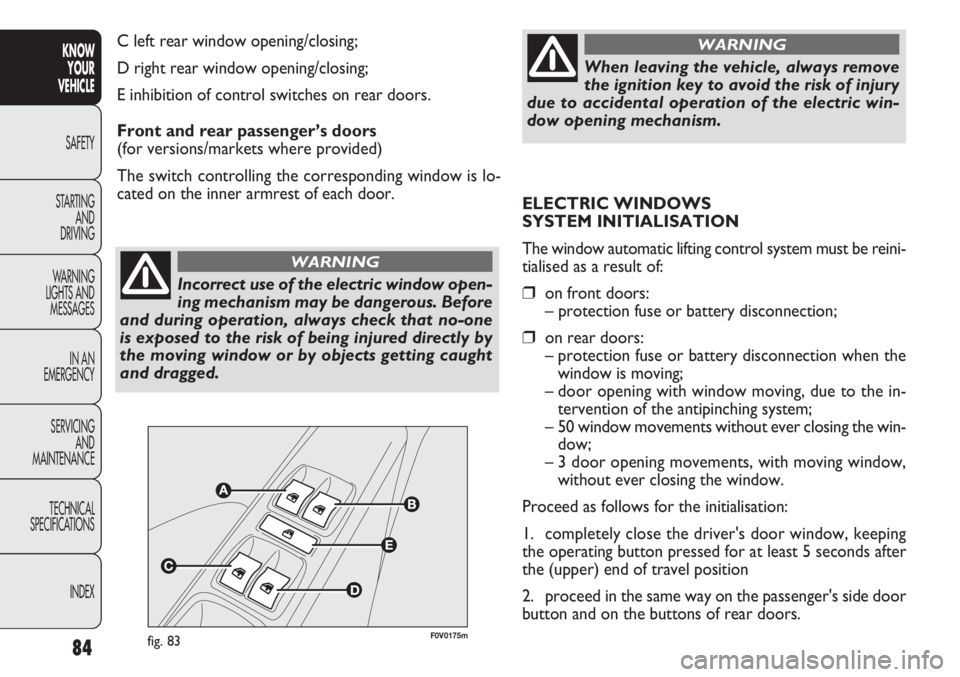
84
KNOWYOUR
VEHICLE
SAFETY
ST AR
TING AND
DRIVING
WARNING
LIGHTS AND MESSAGES
IN AN
EMERGENCY
SERVICING AND
MAINTENANCE
TECHNICAL
SPECIFICATIONS
INDEX
Incorrect use of the electric window open-
ing mechanism may be dangerous. Before
and during operation, always check that no-one
is exposed to the risk of being injured directly by
the moving window or by objects getting caught
and dragged.
WARNING
When leaving the vehicle, always remove
the ignition key to avoid the risk of injury
due to accidental operation of the electric win-
dow opening mechanism.
WARNING
F0V0175mfig. 83
C left rear window opening/closing;
D right rear window opening/closing;
E inhibition of control switches on rear doors.
Front and rear passenger’s doors
(for versions/markets where provided)
The switch controlling the corresponding window is lo-
cated on the inner armrest of each door. ELECTRIC WINDOWS
SYSTEM INITIALISATION
The window automatic lifting control system must be reini-
tialised as a result of:
❒on front doors:
– protection fuse or battery disconnection;
❒on rear doors:– protection fuse or battery disconnection when the window is moving;
– door opening with window moving, due to the in- tervention of the antipinching system;
– 50 window movements without ever closing the win- dow;
– 3 door opening movements, with moving window, without ever closing the window.
Proceed as follows for the initialisation:
1. completely close the driver's door window, keeping
the operating button pressed for at least 5 seconds after
the (upper) end of travel position
2. proceed in the same way on the passenger's side door
button and on the buttons of rear doors.
Page 102 of 283
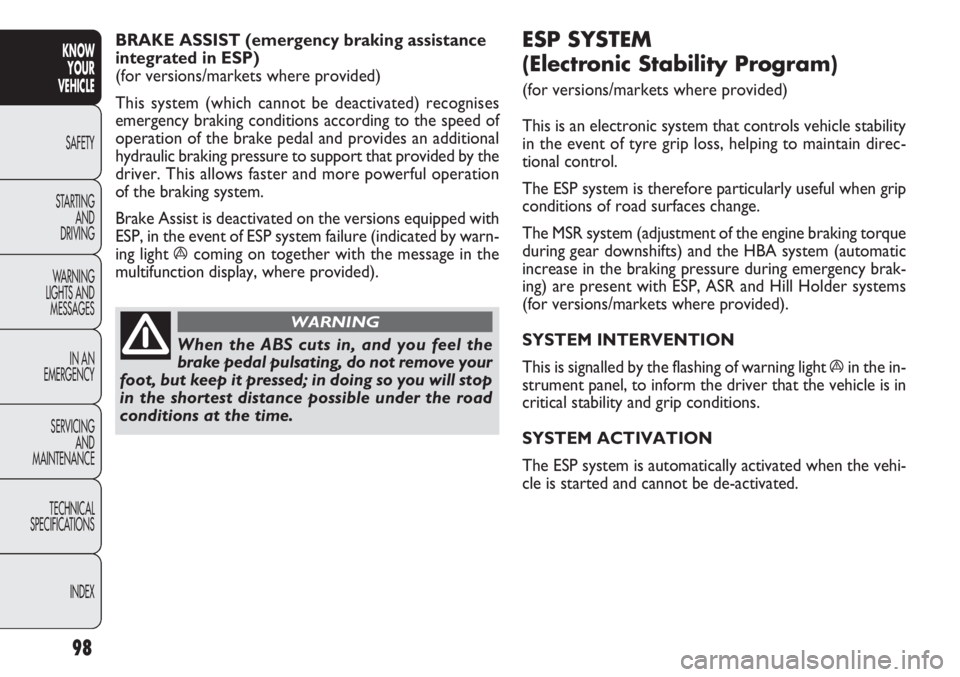
98
KNOWYOUR
VEHICLE
SAFETY
ST AR
TING AND
DRIVING
WARNING
LIGHTS AND MESSAGES
IN AN
EMERGENCY
SERVICING AND
MAINTENANCE
TECHNICAL
SPECIFICATIONS
INDEX
ESP SYSTEM
(Electronic Stability Program)
(for versions/markets where provided)
This is an electronic system that controls vehicle stability
in the event of tyre grip loss, helping to maintain direc-
tional control.
The ESP system is therefore particularly useful when grip
conditions of road surfaces change.
The MSR system (adjustment of the engine braking torque
during gear downshifts) and the HBA system (automatic
increase in the braking pressure during emergency brak-
ing) are present with ESP, ASR and Hill Holder systems
(for versions/markets where provided).
SYSTEM INTERVENTION
This is signalled by the flashing of warning light
áin the in-
strument panel, to inform the driver that the vehicle is in
critical stability and grip conditions.
SYSTEM ACTIVATION
The ESP system is automatically activated when the vehi-
cle is started and cannot be de-activated.
BRAKE ASSIST (emergency braking assistance
integrated in ESP)
(for versions/markets where provided)
This system (which cannot be deactivated) recognises
emergency braking conditions according to the speed of
operation of the brake pedal and provides an additional
hydraulic braking pressure to support that provided by the
driver. This allows faster and more powerful operation
of the braking system.
Brake Assist is deactivated on the versions equipped with
ESP, in the event of ESP system failure (indicated by warn-
ing light
ácoming on together with the message in the
multifunction display, where provided).
When the ABS cuts in, and you feel the
brake pedal pulsating, do not remove your
foot, but keep it pressed; in doing so you will stop
in the shortest distance possible under the road
conditions at the time.
WARNING
Page 103 of 283
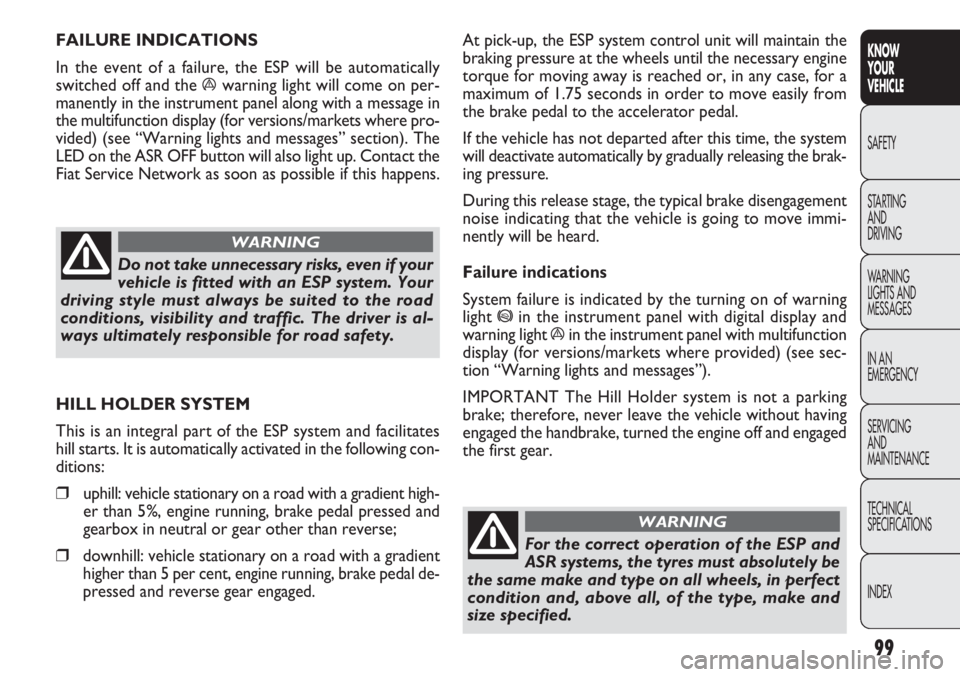
99
KNOW
YOUR
VEHICLE
SAFETY
STAR
TING
AND
DRIVING
WARNING
LIGHTS AND
MESSAGES
IN AN
EMERGENCY
SERVICING
AND
MAINTENANCE
TECHNICAL
SPECIFICATIONS
INDEX
At pick-up, the ESP system control unit will maintain the
braking pressure at the wheels until the necessary engine
torque for moving away is reached or, in any case, for a
maximum of 1.75 seconds in order to move easily from
the brake pedal to the accelerator pedal.
If the vehicle has not departed after this time, the system
will deactivate automatically by gradually releasing the brak-
ing pressure.
During this release stage, the typical brake disengagement
noise indicating that the vehicle is going to move immi-
nently will be heard.
Failure indications
System failure is indicated by the turning on of warning
light
*in the instrument panel with digital display and
warning light
áin the instrument panel with multifunction
display (for versions/markets where provided) (see sec-
tion “Warning lights and messages”).
IMPORTANT The Hill Holder system is not a parking
brake; therefore, never leave the vehicle without having
engaged the handbrake, turned the engine off and engaged
the first gear.
FAILURE INDICATIONS
In the event of a failure, the ESP will be automatically
switched off and the
áwarning light will come on per-
manently in the instrument panel along with a message in
the multifunction display (for versions/markets where pro-
vided) (see “Warning lights and messages” section). The
LED on the ASR OFF button will also light up. Contact the
Fiat Service Network as soon as possible if this happens.
Do not take unnecessary risks, even if your
vehicle is fitted with an ESP system. Your
driving style must always be suited to the road
conditions, visibility and traffic. The driver is al-
ways ultimately responsible for road safety.
WARNING
HILL HOLDER SYSTEM
This is an integral part of the ESP system and facilitates
hill starts. It is automatically activated in the following con-
ditions:
❒uphill: vehicle stationary on a road with a gradient high-
er than 5%, engine running, brake pedal pressed and
gearbox in neutral or gear other than reverse;
❒downhill: vehicle stationary on a road with a gradient
higher than 5 per cent, engine running, brake pedal de-
pressed and reverse gear engaged. For the correct operation of the ESP and
ASR systems, the tyres must absolutely be
the same make and type on all wheels, in perfect
condition and, above all, of the type, make and
size specified.
WARNING
Page 104 of 283
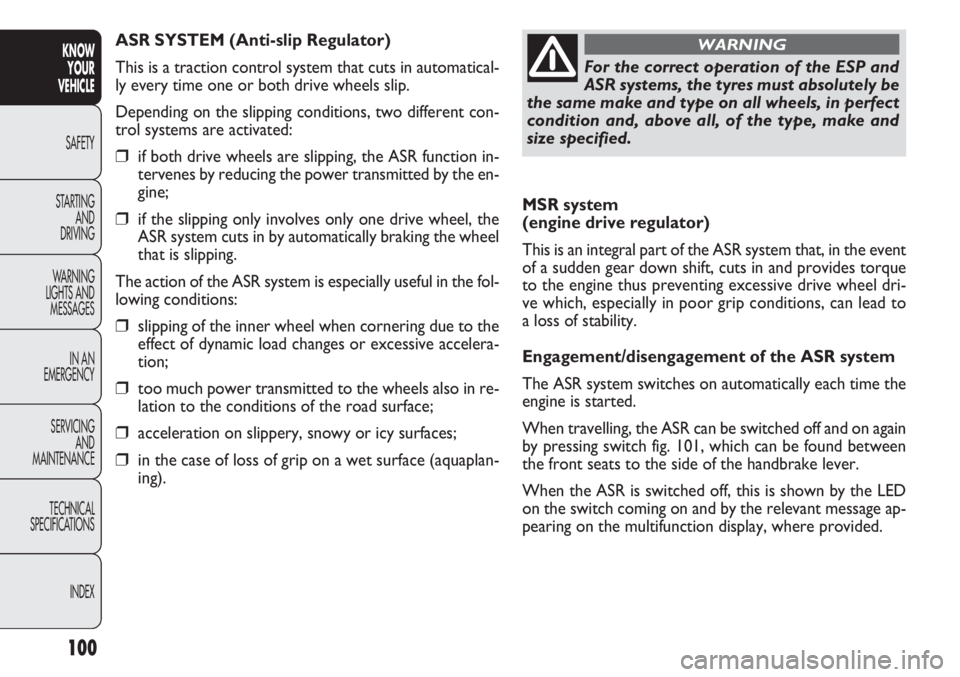
100
KNOWYOUR
VEHICLE
SAFETY
ST AR
TING AND
DRIVING
WARNING
LIGHTS AND MESSAGES
IN AN
EMERGENCY
SERVICING AND
MAINTENANCE
TECHNICAL
SPECIFICATIONS
INDEX
MSR system
(engine drive regulator)
This is an integral part of the ASR system that, in the event
of a sudden gear down shift, cuts in and provides torque
to the engine thus preventing excessive drive wheel dri-
ve which, especially in poor grip conditions, can lead to
a loss of stability.
Engagement/disengagement of the ASR system
The ASR system switches on automatically each time the
engine is started.
When travelling, the ASR can be switched off and on again
by pressing switch fig. 101, which can be found between
the front seats to the side of the handbrake lever.
When the ASR is switched off, this is shown by the LED
on the switch coming on and by the relevant message ap-
pearing on the multifunction display, where provided.
ASR SYSTEM (Anti-slip Regulator)
This is a traction control system that cuts in automatical-
ly every time one or both drive wheels slip.
Depending on the slipping conditions, two different con-
trol systems are activated:
❒if both drive wheels are slipping, the ASR function in-
tervenes by reducing the power transmitted by the en-
gine;
❒if the slipping only involves only one drive wheel, the
ASR system cuts in by automatically braking the wheel
that is slipping.
The action of the ASR system is especially useful in the fol-
lowing conditions:
❒slipping of the inner wheel when cornering due to the
effect of dynamic load changes or excessive accelera-
tion;
❒too much power transmitted to the wheels also in re-
lation to the conditions of the road surface;
❒acceleration on slippery, snowy or icy surfaces;
❒in the case of loss of grip on a wet surface (aquaplan-
ing).
For the correct operation of the ESP and
ASR systems, the tyres must absolutely be
the same make and type on all wheels, in perfect
condition and, above all, of the type, make and
size specified.
WARNING
Page 105 of 283
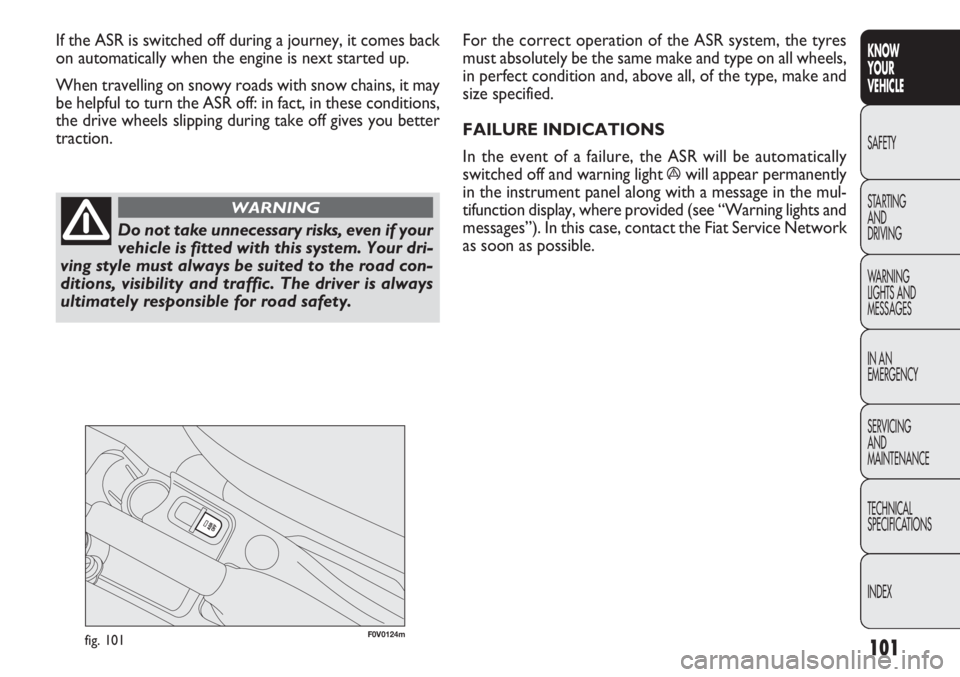
101
KNOW
YOUR
VEHICLE
SAFETY
STAR
TING
AND
DRIVING
WARNING
LIGHTS AND
MESSAGES
IN AN
EMERGENCY
SERVICING
AND
MAINTENANCE
TECHNICAL
SPECIFICATIONS
INDEX
F0V0124mfig. 101
For the correct operation of the ASR system, the tyres
must absolutely be the same make and type on all wheels,
in perfect condition and, above all, of the type, make and
size specified.
FAILURE INDICATIONS
In the event of a failure, the ASR will be automatically
switched off and warning light
áwill appear permanently
in the instrument panel along with a message in the mul-
tifunction display, where provided (see “Warning lights and
messages”). In this case, contact the Fiat Service Network
as soon as possible.
If the ASR is switched off during a journey, it comes back
on automatically when the engine is next started up.
When travelling on snowy roads with snow chains, it may
be helpful to turn the ASR off: in fact, in these conditions,
the drive wheels slipping during take off gives you better
traction.
Do not take unnecessary risks, even if your
vehicle is fitted with this system. Your dri-
ving style must always be suited to the road con-
ditions, visibility and traffic. The driver is always
ultimately responsible for road safety.
WARNING
Page 108 of 283
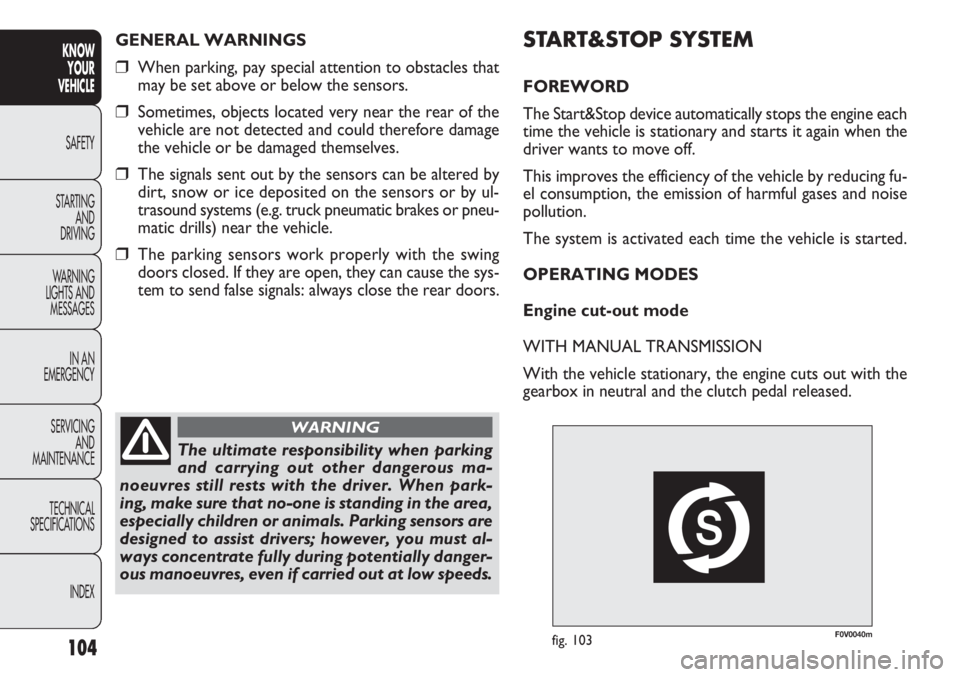
F0V0040mfig. 103
START&STOP SYSTEM
FOREWORD
The Start&Stop device automatically stops the engine each
time the vehicle is stationary and starts it again when the
driver wants to move off.
This improves the efficiency of the vehicle by reducing fu-
el consumption, the emission of harmful gases and noise
pollution.
The system is activated each time the vehicle is started.
OPERATING MODES
Engine cut-out mode
WITH MANUAL TRANSMISSION
With the vehicle stationary, the engine cuts out with the
gearbox in neutral and the clutch pedal released.
104
KNOWYOUR
VEHICLE
SAFETY
ST AR
TING AND
DRIVING
WARNING
LIGHTS AND MESSAGES
IN AN
EMERGENCY
SERVICING AND
MAINTENANCE
TECHNICAL
SPECIFICATIONS
INDEX
GENERAL WARNINGS
❒When parking, pay special attention to obstacles that
may be set above or below the sensors.
❒Sometimes, objects located very near the rear of the
vehicle are not detected and could therefore damage
the vehicle or be damaged themselves.
❒The signals sent out by the sensors can be altered by
dirt, snow or ice deposited on the sensors or by ul-
trasound systems (e.g. truck pneumatic brakes or pneu-
matic drills) near the vehicle.
❒The parking sensors work properly with the swing
doors closed. If they are open, they can cause the sys-
tem to send false signals: always close the rear doors.
The ultimate responsibility when parking
and carrying out other dangerous ma-
noeuvres still rests with the driver. When park-
ing, make sure that no-one is standing in the area,
especially children or animals. Parking sensors are
designed to assist drivers; however, you must al-
ways concentrate fully during potentially danger-
ous manoeuvres, even if carried out at low speeds.
WARNING
Page 122 of 283
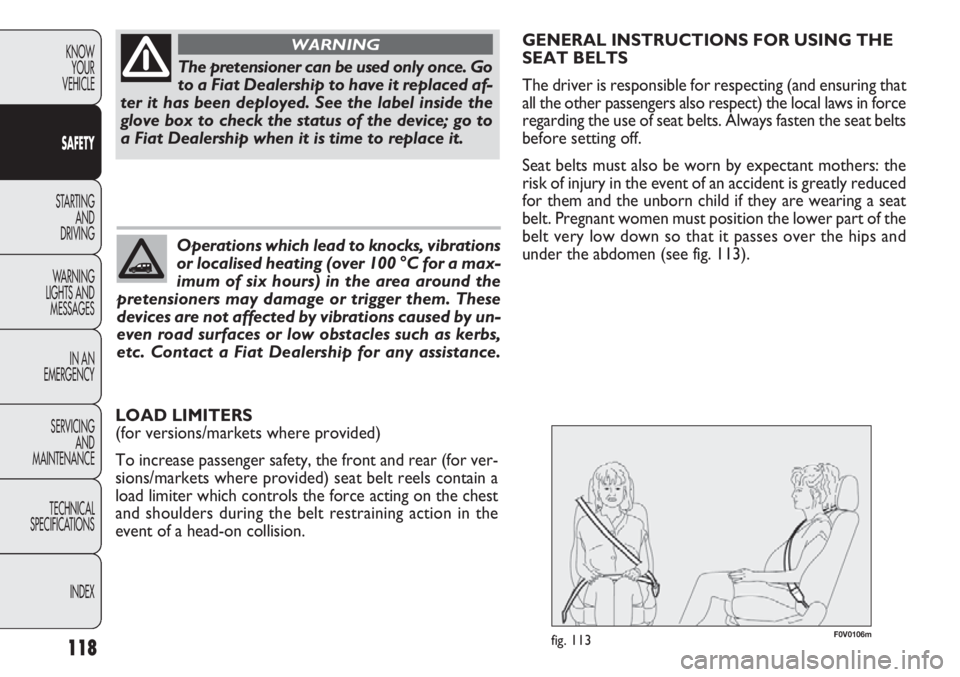
F0V0106mfig. 113118
KNOWYOUR
VEHICLE
SAFETY
STARTING AND
DRIVING
W ARNING
LIGHTS AND MESSAGES
IN AN
EMERGENCY
SERVICING AND
MAINTENANCE
TECHNICAL
SPECIFICA
TIONSINDEX
The pretensioner can be used only once. Go
to a Fiat Dealership to have it replaced af-
ter it has been deployed. See the label inside the
glove box to check the status of the device; go to
a Fiat Dealership when it is time to replace it.
WARNING
Operations which lead to knocks, vibrations
or localised heating (over 100 °C for a max-
imum of six hours) in the area around the
pretensioners may damage or trigger them. These
devices are not affected by vibrations caused by un-
even road surfaces or low obstacles such as kerbs,
etc. Contact a Fiat Dealership for any assistance.
GENERAL INSTRUCTIONS FOR USING THE
SEAT BELTS
The driver is responsible for respecting (and ensuring that
all the other passengers also respect) the local laws in force
regarding the use of seat belts. Always fasten the seat belts
before setting off.
Seat belts must also be worn by expectant mothers: the
risk of injury in the event of an accident is greatly reduced
for them and the unborn child if they are wearing a seat
belt. Pregnant women must position the lower part of the
belt very low down so that it passes over the hips and
under the abdomen (see fig. 113).
LOAD LIMITERS
(for versions/markets where provided)
To increase passenger safety, the front and rear (for ver-
sions/markets where provided) seat belt reels contain a
load limiter which controls the force acting on the chest
and shoulders during the belt restraining action in the
event of a head-on collision.
Page 141 of 283
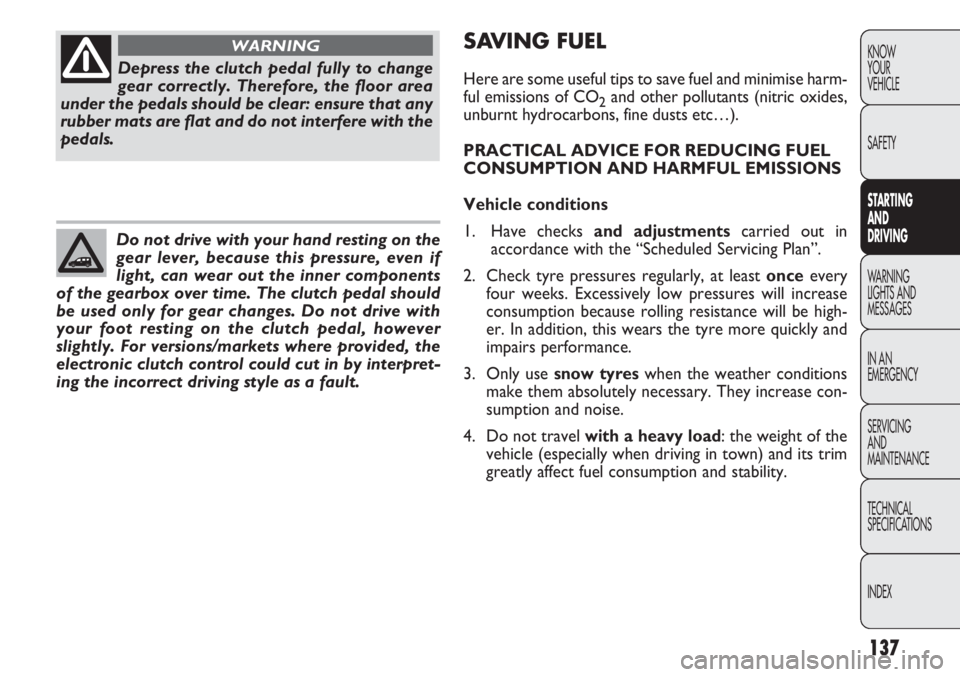
137
KNOW
YOUR
VEHICLE
SAFETY
STARTING
AN
D
DRIVING
WARNING
LIGHTS AND
MESSAGES
IN AN
EMERGENCY
SERVICING
AND
MAINTENANCE
TECHNICAL
SPECIFICA TIONS
INDEX
Depress the clutch pedal fully to change
gear correctly. Therefore, the floor area
under the pedals should be clear: ensure that any
rubber mats are flat and do not interfere with the
pedals.
WARNING
Do not drive with your hand resting on the
gear lever, because this pressure, even if
light, can wear out the inner components
of the gearbox over time. The clutch pedal should
be used only for gear changes. Do not drive with
your foot resting on the clutch pedal, however
slightly. For versions/markets where provided, the
electronic clutch control could cut in by interpret-
ing the incorrect driving style as a fault.
SAVING FUEL
Here are some useful tips to save fuel and minimise harm-
ful emissions of CO
2and other pollutants (nitric oxides,
unburnt hydrocarbons, fine dusts etc…).
PRACTICAL ADVICE FOR REDUCING FUEL
CONSUMPTION AND HARMFUL EMISSIONS
Vehicle conditions
1. Have checks and adjustments carried out in
accordance with the “Scheduled Servicing Plan”.
2. Check tyre pressures regularly, at least once every
four weeks. Excessively low pressures will increase
consumption because rolling resistance will be high-
er. In addition, this wears the tyre more quickly and
impairs performance.
3. Only use snow tyres when the weather conditions
make them absolutely necessary. They increase con-
sumption and noise.
4. Do not travel with a heavy load: the weight of the vehicle (especially when driving in town) and its trim
greatly affect fuel consumption and stability.
Page 143 of 283
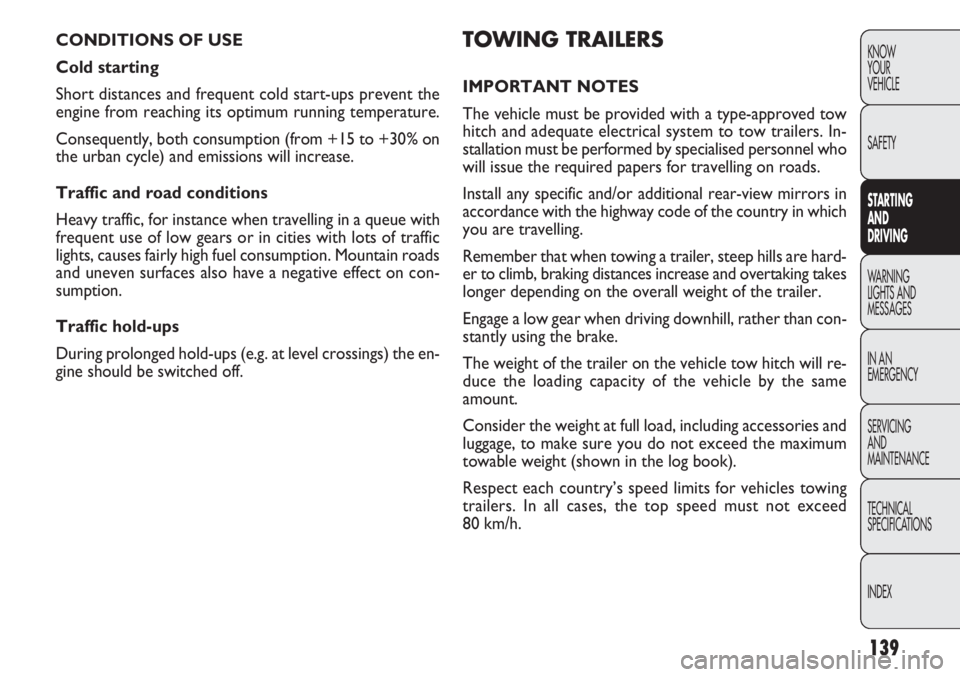
139
KNOW
YOUR
VEHICLE
SAFETY
STARTING
AN
D
DRIVING
WARNING
LIGHTS AND
MESSAGES
IN AN
EMERGENCY
SERVICING
AND
MAINTENANCE
TECHNICAL
SPECIFICA TIONS
INDEX
TOWING TRAILERS
IMPORTANT NOTES
The vehicle must be provided with a type-approved tow
hitch and adequate electrical system to tow trailers. In-
stallation must be performed by specialised personnel who
will issue the required papers for travelling on roads.
Install any specific and/or additional rear-view mirrors in
accordance with the highway code of the country in which
you are travelling.
Remember that when towing a trailer, steep hills are hard-
er to climb, braking distances increase and overtaking takes
longer depending on the overall weight of the trailer.
Engage a low gear when driving downhill, rather than con-
stantly using the brake.
The weight of the trailer on the vehicle tow hitch will re-
duce the loading capacity of the vehicle by the same
amount.
Consider the weight at full load, including accessories and
luggage, to make sure you do not exceed the maximum
towable weight (shown in the log book).
Respect each country’s speed limits for vehicles towing
trailers. In all cases, the top speed must not exceed
80 km/h.
CONDITIONS OF USE
Cold starting
Short distances and frequent cold start-ups prevent the
engine from reaching its optimum running temperature.
Consequently, both consumption (from +15 to +30% on
the urban cycle) and emissions will increase.
Traffic and road conditions
Heavy traffic, for instance when travelling in a queue with
frequent use of low gears or in cities with lots of traffic
lights, causes fairly high fuel consumption. Mountain roads
and uneven surfaces also have a negative effect on con-
sumption.
Traffic hold-ups
During prolonged hold-ups (e.g. at level crossings) the en-
gine should be switched off.
Page 144 of 283
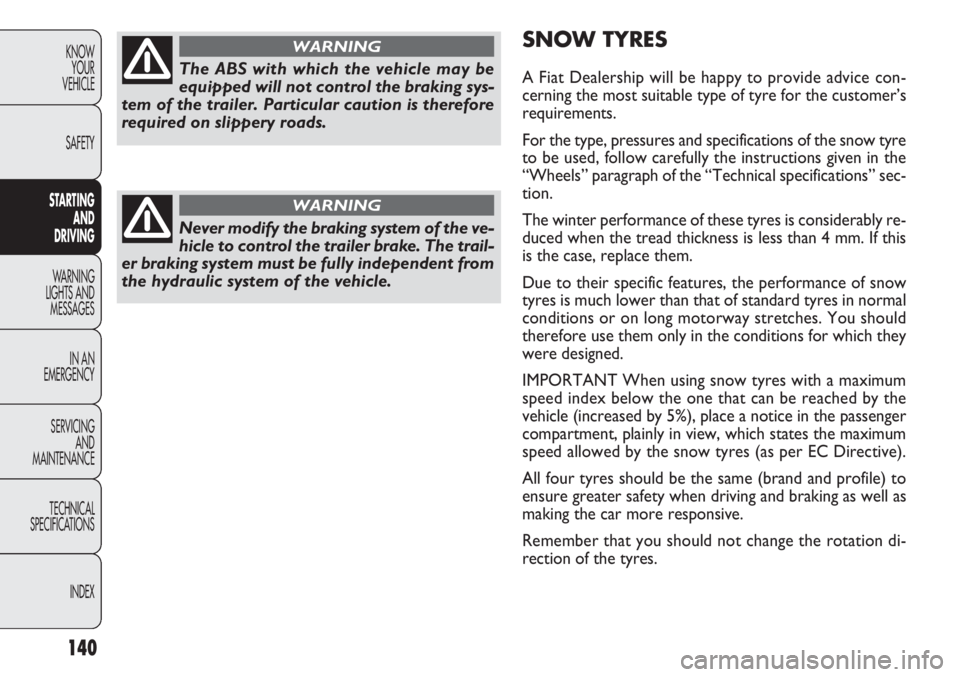
140
KNOWYOUR
VEHICLE
SAFETY
ST ARTING
AN
D
DRIVING
WARNING
LIGHTS AND MESSAGES
IN AN
EMERGENCY
SERVICING AND
MAINTENANCE
TECHNICAL
SPECIFICA TIONS
INDEX
SNOW TYRES
A Fiat Dealership will be happy to provide advice con-
cerning the most suitable type of tyre for the customer’s
requirements.
For the type, pressures and specifications of the snow tyre
to be used, follow carefully the instructions given in the
“Wheels” paragraph of the “Technical specifications” sec-
tion.
The winter performance of these tyres is considerably re-
duced when the tread thickness is less than 4 mm. If this
is the case, replace them.
Due to their specific features, the performance of snow
tyres is much lower than that of standard tyres in normal
conditions or on long motorway stretches. You should
therefore use them only in the conditions for which they
were designed.
IMPORTANT When using snow tyres with a maximum
speed index below the one that can be reached by the
vehicle (increased by 5%), place a notice in the passenger
compartment, plainly in view, which states the maximum
speed allowed by the snow tyres (as per EC Directive).
All four tyres should be the same (brand and profile) to
ensure greater safety when driving and braking as well as
making the car more responsive.
Remember that you should not change the rotation di-
rection of the tyres.The ABS with which the vehicle may be
equipped will not control the braking sys-
tem of the trailer. Particular caution is therefore
required on slippery roads.
WARNING
Never modify the braking system of the ve-
hicle to control the trailer brake. The trail-
er braking system must be fully independent from
the hydraulic system of the vehicle.
WARNING